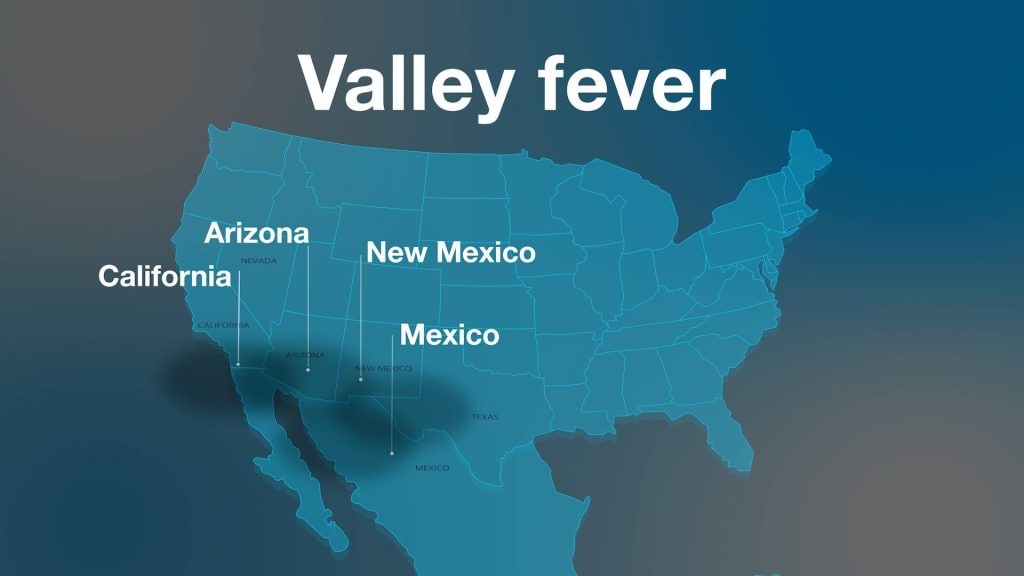Diagnosis
To diagnose valley fever, your doctor may evaluate your medical history and review your signs and symptoms. Valley fever is difficult to diagnose based on the signs and symptoms, because symptoms are usually vague and similar to those that occur in other illnesses. Even a chest X-ray can't help doctors see the difference between valley fever and other forms of lung infection such as pneumonia.
To diagnose valley fever, doctors may order one or more of the following tests:
- Sputum smear or culture. These tests check a sample of the matter that's discharged while coughing (sputum) for the presence of coccidioides organisms.
- Blood tests. Through a blood test, your doctor can check for antibodies against the fungus that causes valley fever.
If doctors think you may have pneumonia due to valley fever, they may also order imaging tests, such as a computed tomography (CT) scan, Magnetic resonance imaging (MRI) or chest X-ray.
If needed, doctors may remove a sample of tissue from the lungs for testing.
In some cases, doctors may do a skin test to find out if you've had valley fever in the past and have developed immunity.
Treatment
Valley fever usually involves supportive care and sometimes medications.
Rest
Most people with acute valley fever don't require treatment. Still, doctors carefully monitor people with valley fever.
Antifungal medications
If symptoms don't improve, last a long time or become worse, or you're at increased risk of complications, your doctor may prescribe an antifungal medication, such as fluconazole. Antifungal medications are also used for people with chronic or disseminated disease.
The antifungal drugs fluconazole (Diflucan) or itraconazole (Sporanox, Tolsura) are generally used for all but the most serious forms of coccidioidomycosis disease.
All antifungals can have serious side effects. But these side effects usually go away once the medication is stopped. Possible side effects of fluconazole and itraconazole are nausea, vomiting, stomach pain and diarrhea. Side effects of fluconazole may be hair loss, dry skin, dry mouth and chapped lips.
More serious infection may first be treated with an intravenous antifungal medication such as amphotericin B (Abelcet, Ambisome, others).
Three newer medications — voriconazole (Vfend), posaconazole (Noxafil) isavuconazonium sulfate (Cresemba) — may also be used to treat more-serious infections.
For many people, a single bout of valley fever results in lifelong immunity. But the disease can be reactivated, or you can be reinfected if your immune system is significantly weakened.
Clinical trials
Explore Mayo Clinic studies testing new treatments, interventions and tests as a means to prevent, detect, treat or manage this condition.
Preparing for your appointment
Make an appointment with your doctor if you develop signs or symptoms of valley fever and are in or have recently returned from a region where this condition is common.
Here's some information to help you get ready and know what to expect from your doctor.
Information to gather in advance
- Pre-appointment restrictions. At the time you make your appointment, ask if there are any restrictions you need to follow in the time leading up to your visit.
- Symptom history. Write down any symptoms you've been experiencing, and for how long.
- Recent exposure to possible sources of infection. Your doctor will be especially interested to know if you have recently traveled, and where.
- Medical history. Make a list of your key medical information, including other conditions for which you're being treated and any medications, vitamins or supplements you're currently taking.
- Questions to ask your doctor. Write down your questions in advance so that you can make the most of your time with your doctor.
The list below suggests questions to raise with your doctor about valley fever. Don't hesitate to ask more questions during your appointment.
- What's the most likely cause of my symptoms?
- What kinds of tests do I need?
- What treatment approach do you recommend, if any?
- I have these other health conditions. How can I best manage these conditions together?
- If you're recommending medications, are there any possible side effects?
- How long do you expect a full recovery to take, and will I need a follow-up appointment?
- Am I at risk of any long-term complications from this condition?
What to expect from your doctor
Your doctor is likely to ask you a number of questions. Being ready to answer them may reserve time to go over any points you want to talk about in-depth. Your doctor may ask:
- What are your symptoms?
- When did you first begin experiencing symptoms?
- Have your symptoms gotten worse over time?
- Have you recently traveled? Where and when?
- Does your work or recreational activities involve spending time in dusty outdoor environments?
- Are you pregnant?
- Have you been diagnosed with any other medical conditions?
- Are you currently taking any medications, including over-the-counter and prescription drugs as well as any vitamins and supplements?
